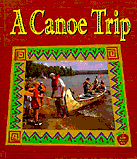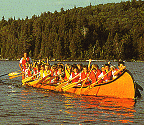

![]()

|
A Canoe Trip.
Writers/Editors: Bobbie Kalman, Tammie Everts, David Schimpky, Samantha
Crabtree. Subject Headings:
Grades 3 - 6 / Ages 8 - 11.
**/4
|
A CANOE TRIP is a visually appealing book -- a sort of coffee-table book for the eight to eleven set. It appears to be primarily promotional material for the children's camp system of Ontario.

The book is well
laid-out and organized, with a table of contents and index, and a
vocabulary section that defines important but uncommon words. A
Canoe Trip emphasizes safety and environmental awareness
throughout, with practical suggestions on how to deal with potentially
dangerous situations (like fires or encounters with bears).
Along with
teaching the basic parts of a canoe, the book explains the two basic
strokes used in canoeing, the sweep and the J-stroke. Fun is emphasized
throughout, and the main group of boys pictured certainly seem to be
having fun.
The major
drawback to A Canoe Trip is that it lacks a clear target
and purpose. The cover suggests it's for young children, but the pictures
include young people up to the teen years. The language used varies in
the same manner.
The book suggests
that children will go a week-long camp, yet the suggested list of food
and supplies would not last more than a few days. And though the book
stresses safety throughout, it fails to address the effects of being on
the water in the bright sun: there is one casual mention of a sun-screen,
but nothing about sunglasses, or the importance of having enough water in
the canoe to prevent dehydration. The same applies to insect repellent.
This lack of
realism extends to situations such as portaging. According to A
Canoe Trip, "Portaging is a welcome rest from paddling." One
wonders how these canoes were moved, because there's no mention of who
moved them or how.

Though it was
good to include a practical section on what to do if you wander off on
your own and become lost, it would have been better if they'd included
the whistle the child is supposed to use to be found in the supply list.
Similarly, though the illustrations show marshmallows, canned beans, and
some sort of hot drink, none of these items are included on the food
list.
It's difficult to
understand why a book of this kind, published in the nineties, has such a
preponderance of males in the photographs. It's also hard to understand
why the authors still use imperial rather than metric measurements in
their instructions.
To sum up, this
book lacks a focus; there are too many words for a coffee-table book, but
certainly not enough information to prepare a child to go on a real canoe
trip. Not unless they were to sign up with one of those excellent camps
in Ontario. A Canoe Trip does, however, look beautiful.

Recommended with reservations -- well packaged, but lacking in substance.
William F. Benson is a school psychologist in Nanaimo, British Columbia with interests in athletics and the outdoors.
To comment on this title or this review, send mail to cmeditor@mts.net.
![]()
Copyright © 1996 the Manitoba Library Association.
Reproduction for personal use is permitted only if this copyright notice
is maintained. Any other reproduction is prohibited without permission.
Published by
The Manitoba Library Association
ISSN 1201-9364
![]()